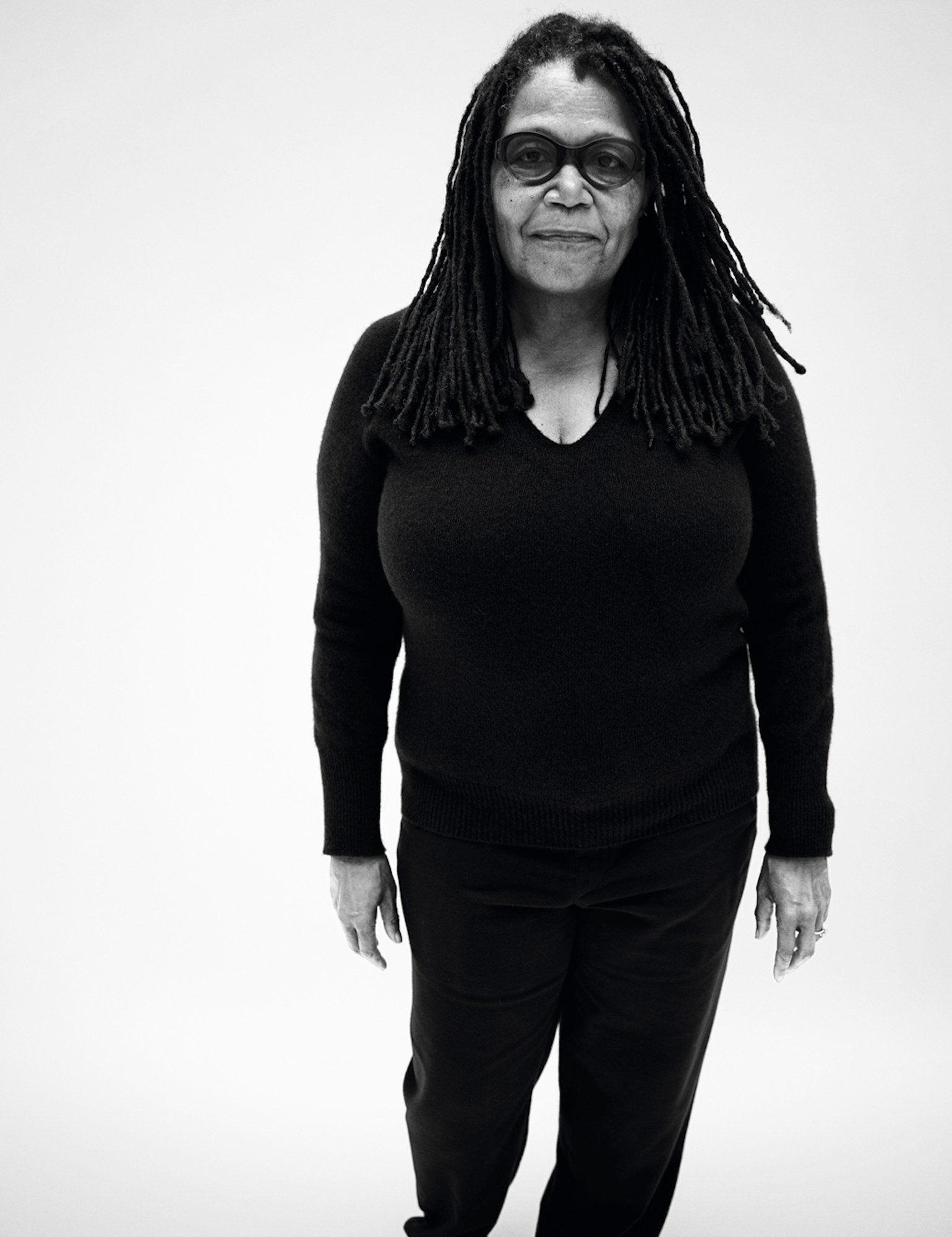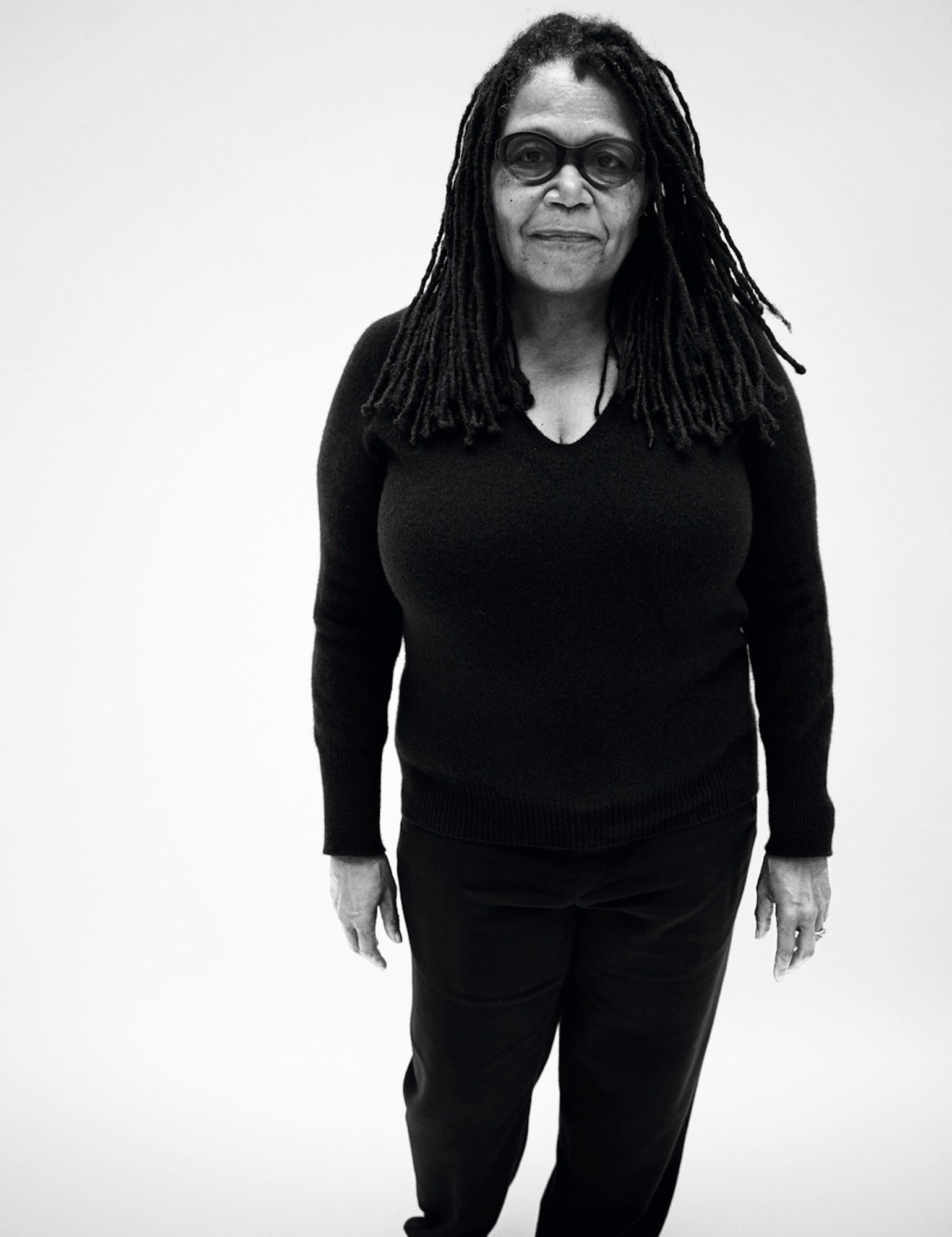This story originally appeared in i-D’s The Darker Issue, no. 365, Winter 2021. Order your copy here.
Linda Goode Bryant is a documentary filmmaker and activist. She founded the gallery Just Above Midtown in 1974, one of New York City’s first Black owned galleries, and a crucial and important space for Black creativity in the city at the time, supporting the work of pioneering artists who are now household names.
Can you talk a little bit about when you first knew that you were an artist? When did you decide to pursue that and how did it evolve?
I really liked Pippi Longstocking. She was probably very influential to me in realising that I was an artist. There were no adults. I thought she was kickass. She had all these ideas and she could take care of herself. I really liked that. Then the Dillards, our neighbours, their house was also a hotbed for artists, and Mr. Dillard always intrigued me. It was when I saw Mr. Dillard’s art that I realised art was magical. He would collect things people threw out, like a junk man, and he’d put it in his garage and he’d make it alive again. The stuff we thought was dead and unusable, he would bring to life again.
How old were you at this time?
I was probably around eight years old.
You were young.
And Mrs. Dillard was radically Black. As I get older, I realise how much they influenced me.
You and I have discussed your view of your gallery, Just Above Midtown, as an artwork in itself. When you were starting JAM, at the time, did you conceptualise it as an artwork or did you think about it in that way later?
I think it was because of Mr. Dillard; his picking up all of those discarded objects. That was such an expression of possibility and that has been with me forever. That is what I believe: use what you have to create what you need. That is what he did.
All of that belief and possibility in JAM was also rooted in the people my parents knew and even the church. There is no way not to respect and appreciate the Black church. I felt Arthur Jafa’s piece akingdomcomethas was about this. Our capacity as Black folks to believe against every fact and experience and situation around us, we believe in our ability to withstand that and keep going. I certainly have that kind of belief.
Your family was in the Pentecostal church, right?
Yes, Pentecostal. But I never got baptised. They tried. I rejected the dishonesty of the power and how essential women were because they couldn’t rise up the ranks back then. You had to serve the men who were the preachers and the deacons. But the women in the family were also fierce, especially in the church.
Why do you think the church became their sphere of influence?
That’s a good question, Mari. I mean that deeply. I think that’s how they expressed their ability to build and create. It’s making me think about that differently. In my mind, they weren’t acknowledged for doing it but I think that was their thing. They built the foundations of those churches. It was their domain: cooking the food, organising it, making sure we had enough money. I was in church three or four days out of the week. Even the meetings with the preachers that would do their thing and say “Heal!” But I didn’t believe that.

From day one you were skeptical?
Yes, but Black folks believe.
Do you think they truly believed? I’m wondering now, as we talk about the women in the church, if you ever sensed a kind of skepticism but that they also wanted to invest and build the community?
Did they believe and need to believe in God? Yes. Was God their saviour and their lover, too? Yes. When you’re falling out, it looks like an orgasm to me. I’m not saying that’s how every orgasm is but, you know, they were communing with God. They believed in that, or at least they needed it, and thus they believed in it to get through the lives they lived.
With JAM though, it really comes down to the time that I asked my father for a popsicle and he said, “no.” I said, “why?” He said, “because it’s my money and I can decide how I spend it.” And that made sense to me. I just said, “I guess I have to make my own money.” So, I made a musical that summer, following Judy Garland and Mickey Rooney and even The Little Rascals. This is where I began to see that you can be creative and create revenue. This was the beginning of me starting projects and building organisations. I was really propelling that and opening up. They would say, “No one is going to buy the lemonade” and I would say, “Well, we’re not charging them for the musical! They are going to buy the lemonade.” I have always been faced with doubters but it was so successful. That musical and lemonade stand is probably why we’re sitting here now. It was sealed from that point.
But, it upset my Dad. He really came after me when it was over. He was my nurturer. My mom had issues with me. I’ll never forget the conversation that my mother and I had during the late 60s when I was involved in Civil Rights and Black Power protests in Columbus, and later in Atlanta. That was my shit, but both of my parents were concerned about that. Senga was right, my parents just hoped I would land on my feet. My mother, who was very fair skinned and had straight hair, asked me, “What if I got mistaken for a white person, during a protest?” And I said, “You’d have to take one for the cause.”
“There is no way not to respect and appreciate the Black church, and our capacity as Black folks to believe against every fact and experience and situation around us. We believe in our ability to withstand and keep going. The belief in God when everything is slapping you upside the head. I certainly have that kind of belief. ”
You were very serious.
Part of that was me saying, “How does it feel to be on the outside of that?” But what I didn’t understand at the time, which was really special, was her saying “Do you think it is a privilege for me to look the way that I look? To always only be valued for how you look? Not whether you have a brain or what you believe or what is in your heart. Think about it again.” I had never thought about it that way.
It reminds me of something you’ve talked about with me before, the idea that Blackness is not the absence of whiteness but it is the presence of Blackness. Can you talk a little bit about where that came from?
It’s related to how I was always surprised by the discomfort and fear that I could observe in Black people around white people. I didn’t have it. Maybe it has something to do with the fact that I was the first kid on my mother’s side to have nappy hair. Many of them passed. I was the first in generations of people with very fair skin and straight hair. After being able to say ‘Mommy’ and ‘Daddy’, the first sentence I was able to understand was “It’s a shame you’re not as white as your mom, it’s a shame your hair is not as straight or long as your mom’s.” But I never understood that. I didn’t see it as a shame. It was just different but it didn’t make a difference to me. The privileging of whiteness never made sense to me.
Credits
Photography Mario Sorrenti
Fashion Alastair McKimm
Hair Bob Recine
Make-up Aaron de Mey at Art Partner using Makeup Forever
Nail technician Honey at Exposure NY using Smith & Cult
Photography assistance Kotaro Kawashima and Javier Villegas
Digital technician Chad Meyer
Fashion assistance Madison Matusich, Casey Conrad and Jermaine Daley
Hair assistance Kazuhide Katahira
Make-up assistance Tayler Treadwell
Production Katie Fash, Layla Néméjanski and Steve Sutton
Production assistance William Cipos
Casting director Samuel Ellis Scheinman for DMCASTING

